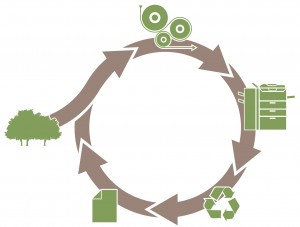
Industry sector accounts for the second highest contribution of greenhouse gases, just after energy sector. According to Mann and Kump, in 2004 industry sector released 19.4% of all greenhouse gas emissions. However, thanks to technology, this sector has great room for improvement in terms of environmental impact. One case in point within industry sector is the publishing industry. It is among the most drastically changed by technology in the past decade. Those changes are exciting, noticeable in everyday life and significantly reducing carbon footprint of the industry.
To start with, let’s take a word connection game. As you try to connect one word with the next, think about the climate impact of the connections: tropical forest, paper mills, printing houses, newspaper, mailboxes, trash bins. Yes, that is the typical life cycle of newspapers. You may ask what if newspapers are recycled? According to Green Press Initiative, an environmental advocate in the publishing industry, consumption of paper for newsprint is 9.2 million tons per year, of which the average amount of recycled material used is 32%. That means 6 million tons of virgin fiber is used to make newspaper in the US every year. Unfortunately, that was just the number for newspapers. Publishers also turn out magazines, books, catalogs and all kinds of other publications.
Paper is a very carbon-intensive product (life-cycle of paper below). A report by Wood Consumption suggests that production of every ton of paper requires two to four tons of trees. In fact, more than 40% of logged trees are used in paper production. The process of producing pulp and white paper also requires massive input of energy and chemicals. When not recycled, which happens to 50% of all paper, paper products end up in landfills, taking up space and producing methane.

On the bright side, recent technology has suggested ways to reduce environmental impact of the publishing industry. Most noticeably, newspapers industry has gone online. A research by Nielsen, a global market research firm, suggested that online newspapers have been growing at double-digit rates in recent years while circulation for print papers is on a constant downward trend. Philip Meyer, a researcher and writer on journalism, using current growth rates, has extrapolated that newsprint in the US will die in the first quarter of 2043. As a result, in the next few decades, the publishing industry will be able to cut back on environmental impact even more significantly.
Technology does not only affect newsprint. The recent popularity of Amazon’s Kindle, an e-book reader, together with Google Library project have suggested that in the near future, more and more books will be available in electronic form. Since its release in 2007, Kindle has constantly beaten analysts’ sales forecast. Amazon has projected to sell 500,000 units of Kindle this year. In its lifetime, each Kindle unit theoretically helps eliminate the printing of thousands of books. In terms of software and services, Google Books Library Project is working with major libraries with a goal of “creating a comprehensive, searchable, virtual card catalog of all books in all languages”. When all these projects take off, they will create a platform for further digitalization of publications. This will only further decrease our reliance on paper.

In the publishing industry, we have seen a case of technology improvement not only making reading more convenient but also effectively reducing greenhouse gases emissions. The driver behind the technology may not be the concern for the environment, yet its impact helps reduce carbon footprint. This is a very good example of an industry going green and providing more lifestyle choices at the same time.
Video on future of books: http://www.youtube.com/watch?v=K8SNrKDoTHQ
Tags: industry sector, Luan Nguyen, online newspaper, publishing, technological lens